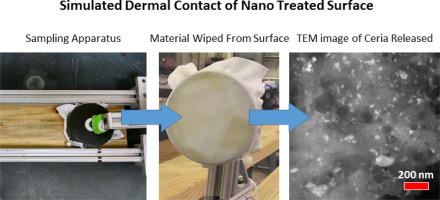当前位置:
X-MOL 学术
›
Sci. Total Environ.
›
论文详情
Our official English website, www.x-mol.net, welcomes your feedback! (Note: you will need to create a separate account there.)
Dermal transfer and environmental release of CeO2 nanoparticles used as UV inhibitors on outdoor surfaces: Implications for human and environmental health
Science of the Total Environment ( IF 9.8 ) Pub Date : 2017-09-20 , DOI: 10.1016/j.scitotenv.2017.09.050 Justin G. Clar , William E. Platten , Eric J. Baumann , Andrew Remsen , Steve M. Harmon , Christina L. Bennett-Stamper , Treye A. Thomas , Todd P. Luxton
Science of the Total Environment ( IF 9.8 ) Pub Date : 2017-09-20 , DOI: 10.1016/j.scitotenv.2017.09.050 Justin G. Clar , William E. Platten , Eric J. Baumann , Andrew Remsen , Steve M. Harmon , Christina L. Bennett-Stamper , Treye A. Thomas , Todd P. Luxton

|
A major area of growth for “nano-enabled” consumer products have been surface coatings, including paints stains and sealants. Ceria (CeO2) nanoparticles (NPs) are of interest as they have been used as additives in these these products to increase UV resistance. Currently, there is a lack of detailed information on the potential release, and speciation (i.e., ion vs. particle) of CeO2 NPs used in consumer-available surface coatings during intended use scenarios. In this study, both Micronized-Copper Azole pressure-treated lumber (MCA), and a commercially available composite decking were coated with CeO2 NPs dispersed in Milli-Q water or wood stain. Coated surfaces were divided into two groups. The first was placed outdoors to undergo environmental weathering, while the second was placed indoors to act as experimental controls. Both weathered surfaces and controls were sampled over a period of 6 months via simulated dermal contact using methods developed by the Consumer Product Safety Commission (CPSC). The size and speciation of material released was determined through sequential filtration, total metals analysis, X-Ray Absorption Fine Structure Spectroscopy, and electron microscopy. The total ceria release from MCA coated surfaces was found to be dependent on dispersion matrix with aqueous applications releasing greater quantities of CeO2 than stain based applications, 66 ± 12 mg/m2 and 36 ± 7 mg/m2, respectively. Additionally, a substantial quantity of CeO2 was reduced to Ce(III), present as Ce(III)-organic complexes, over the 6-month experimental period in aqueous based applications.
中文翻译:

在户外表面上用作紫外线抑制剂的CeO 2纳米粒子的皮肤转移和环境释放:对人类和环境健康的影响
“纳米技术”消费产品的主要增长领域是表面涂料,包括油漆渍和密封剂。由于二氧化铈(CeO 2)纳米颗粒(NPs)已被用作这些产品中的添加剂以提高抗紫外线性,因此受到关注。当前,在预期使用场景中,缺乏有关消费者可使用的表面涂料中使用的CeO 2 NP的潜在释放和形态(即离子对颗粒)的详细信息。在这项研究中,微粉化的铜Azole加压处理的木材(MCA)和市售的复合地板都用CeO 2涂覆NP分散在Milli-Q水或木材污渍中。涂层表面分为两组。第一个放置在室外进行环境风化,第二个放置在室内作为实验对照。使用消费者产品安全委员会(CPSC)开发的方法,通过模拟的皮肤接触在6个月的时间内对风化的表面和对照进行了采样。通过顺序过滤,总金属分析,X射线吸收精细结构光谱和电子显微镜确定释放的物质的大小和形态。发现从MCA涂层表面释放的二氧化铈总量取决于分散基体,水性应用比基于污渍的应用释放出更多的CeO 2,为66±12 mg / m 2。和分别为36±7 mg / m 2。另外,在水基应用中,在6个月的实验期内,大量CeO 2还原为Ce(III)-有机配合物形式的Ce(III)。
更新日期:2017-09-21
中文翻译:

在户外表面上用作紫外线抑制剂的CeO 2纳米粒子的皮肤转移和环境释放:对人类和环境健康的影响
“纳米技术”消费产品的主要增长领域是表面涂料,包括油漆渍和密封剂。由于二氧化铈(CeO 2)纳米颗粒(NPs)已被用作这些产品中的添加剂以提高抗紫外线性,因此受到关注。当前,在预期使用场景中,缺乏有关消费者可使用的表面涂料中使用的CeO 2 NP的潜在释放和形态(即离子对颗粒)的详细信息。在这项研究中,微粉化的铜Azole加压处理的木材(MCA)和市售的复合地板都用CeO 2涂覆NP分散在Milli-Q水或木材污渍中。涂层表面分为两组。第一个放置在室外进行环境风化,第二个放置在室内作为实验对照。使用消费者产品安全委员会(CPSC)开发的方法,通过模拟的皮肤接触在6个月的时间内对风化的表面和对照进行了采样。通过顺序过滤,总金属分析,X射线吸收精细结构光谱和电子显微镜确定释放的物质的大小和形态。发现从MCA涂层表面释放的二氧化铈总量取决于分散基体,水性应用比基于污渍的应用释放出更多的CeO 2,为66±12 mg / m 2。和分别为36±7 mg / m 2。另外,在水基应用中,在6个月的实验期内,大量CeO 2还原为Ce(III)-有机配合物形式的Ce(III)。



























 京公网安备 11010802027423号
京公网安备 11010802027423号